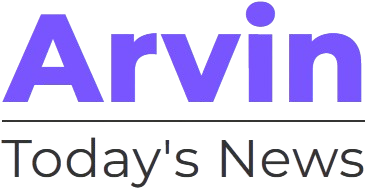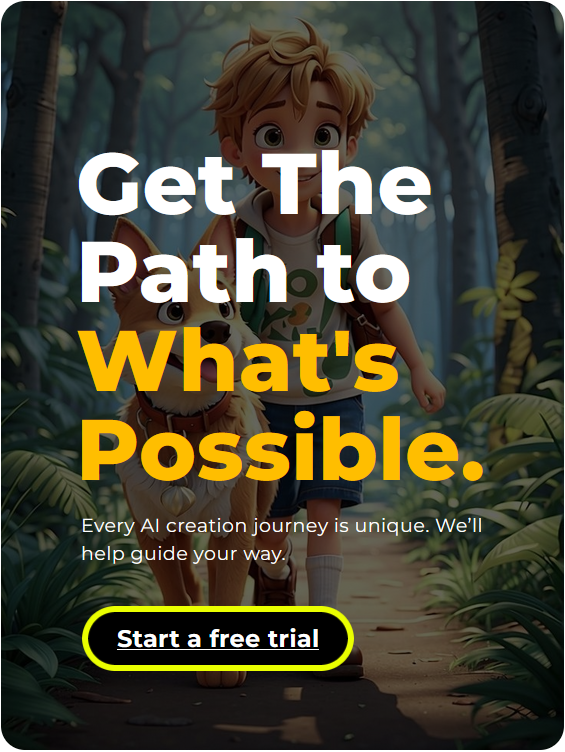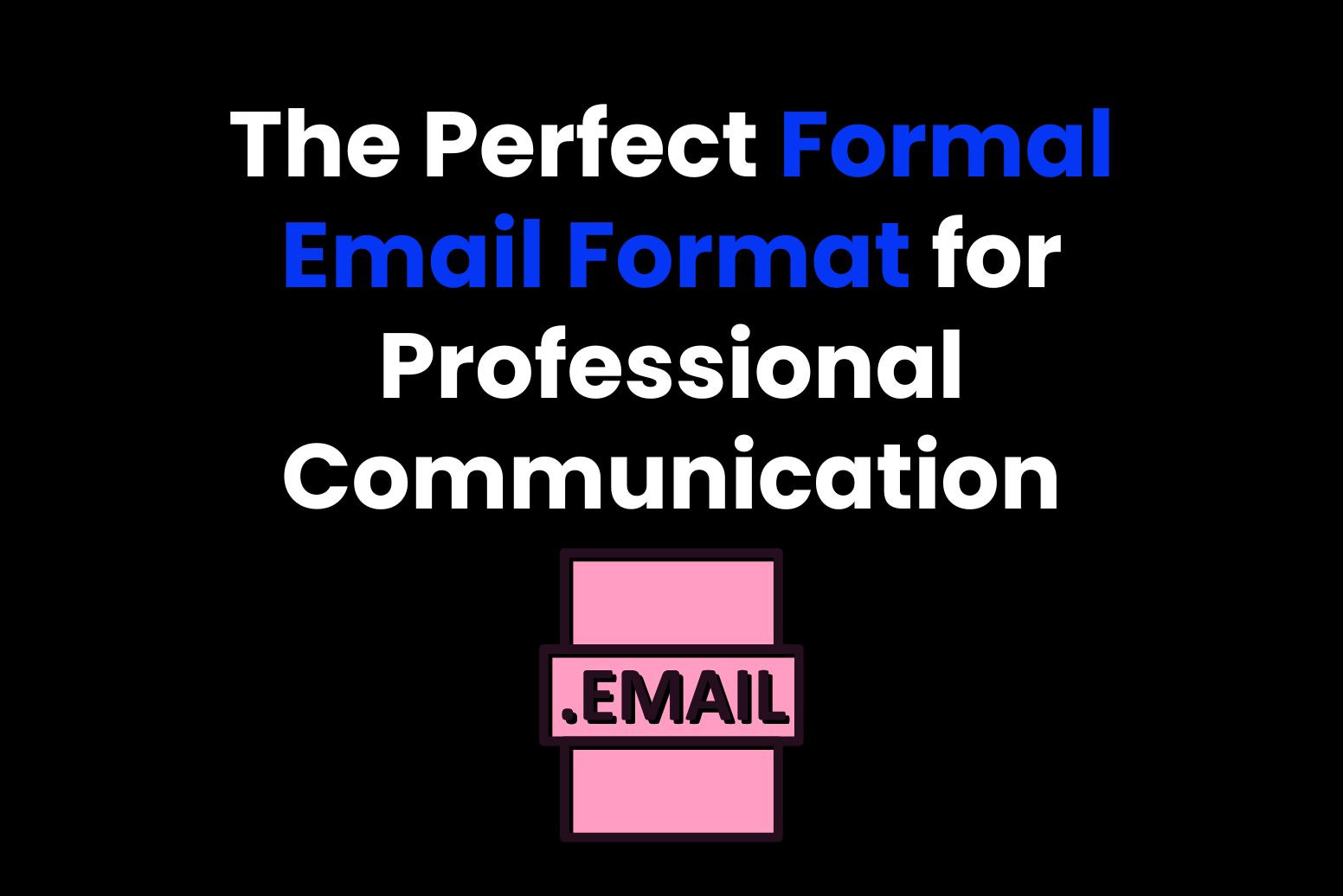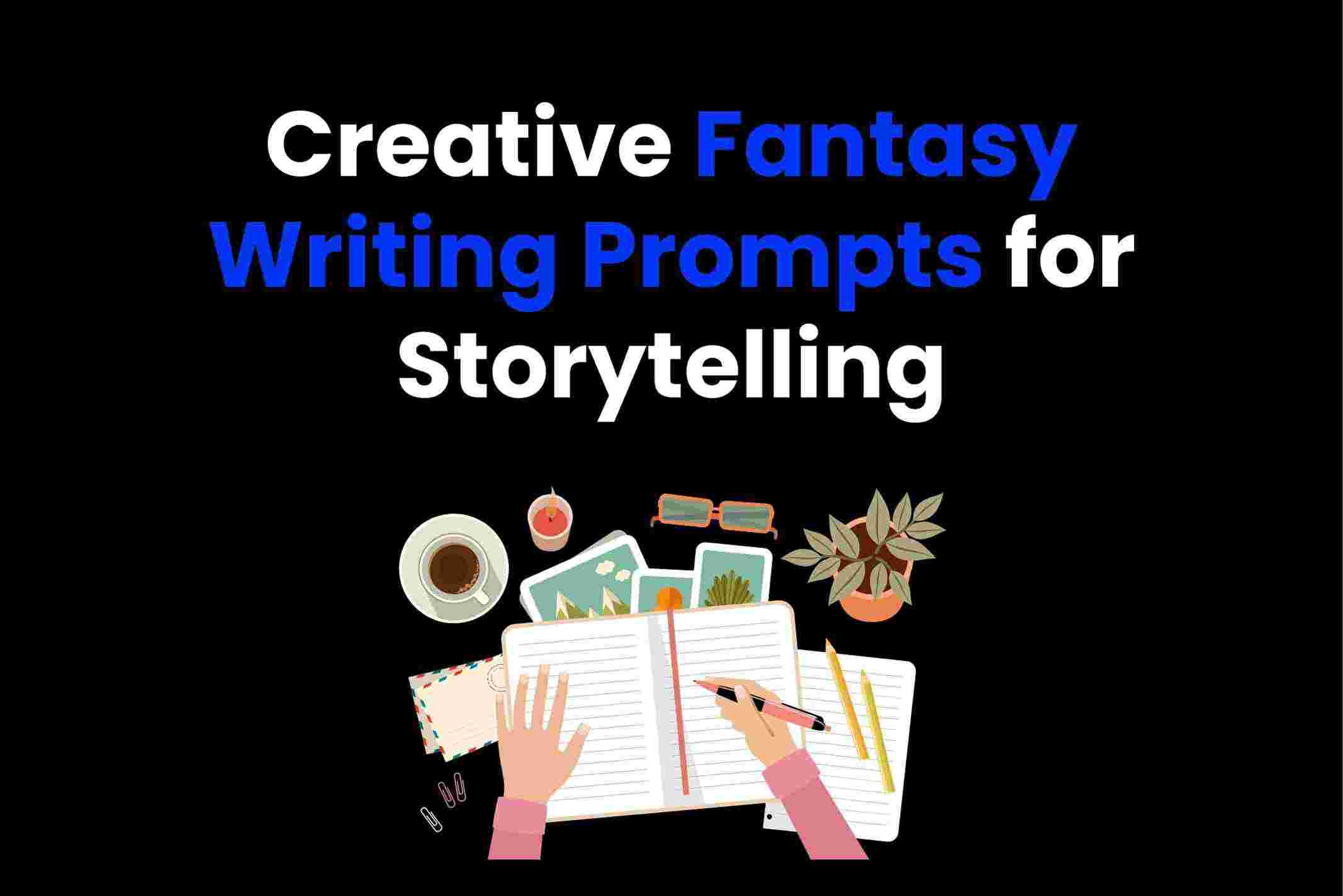Did your resume get rejected for the 100th time, and you’re just wondering, “Did I get rejected again”? The problem is not with your credentials but the way you put them out there. Even the most impressive credentials will fall flat if you don’t know how to format a resume properly.
You just have a few seconds to make an impression, and a good one too. If you don’t know how an ideal resume should look like, don’t worry! In this article, we’ll discuss the different types of resume, essential guidelines to craft a perfect resume, common pitfalls to avoid, and everything in between. Let’s start your guide on how to format a resume that recruiters actually read!

Why Formatting Your Resume Matters?
If you’re having second thoughts about whether you should invest your time to make a decent resume or not, here’s why you should:
First Impressions Are Everything
Imagine a recruiter who is high on caffeine and as busy as a detective trying to find a serial killer. Would a roughly formatted and hard to read resume compel him to read your entire resume or would it make him even more sleepy?
You need a resume format that will earn you a second look from the recruiter. A clean, organized layout will help you stand out from the pile of resumes and land your dream job.
Robots Are Watching You Too
Most companies these days use the Applicant Tracking System (ATS) to sift through the flood of resumes they receive. You can think of ATS as a super picky robot who doesn’t have patience with fancy graphics, funky fonts, or creative layouts.
Only a specific resume format would pass through the system, and it won’t let you off the hook if you deviate. This is why it is important to have a properly formatted resume or else you won’t even get a chance at an interview because the recruiter won’t receive your resume at all.
Understanding Different Types Of Resumes
Understanding different types of resumes is important so that you know how to format a resume according to the situation. Here are 3 types of resumes that are commonly being used all across the globe:
Chronological Resume
A chronological resume format is the one in which you list resumes in a reverse chronological order i.e. you start from your most recent job experience. It is the best resume format for you if you have a consistent work history because the employer will know you have recent similar work experience.
Pros:
Shows your career stability
Highlights relevant experience
Cons:
Not ideal for those with gaps in their resume
Functional Resume
A functional resume focuses more on your skills and experience rather than your work history.
Pros:
Great for those with gaps in employment
Highlights transferable skills
Cons:
Difficult for employers to track your employment history
Combination Resume
A combination resume, just like the name suggests, combines aspects of both functional and chronological resumes. It not only showcases your skills but also highlights your work history.
Pros:
Flexibility to highlight skills or work experience prominently
Suitable for most resume seekers
Cons:
Can become lengthy if not carefully structured
Don’t know which resume you should make? Ask Arvin AI, and make a resume that will help you stand out!
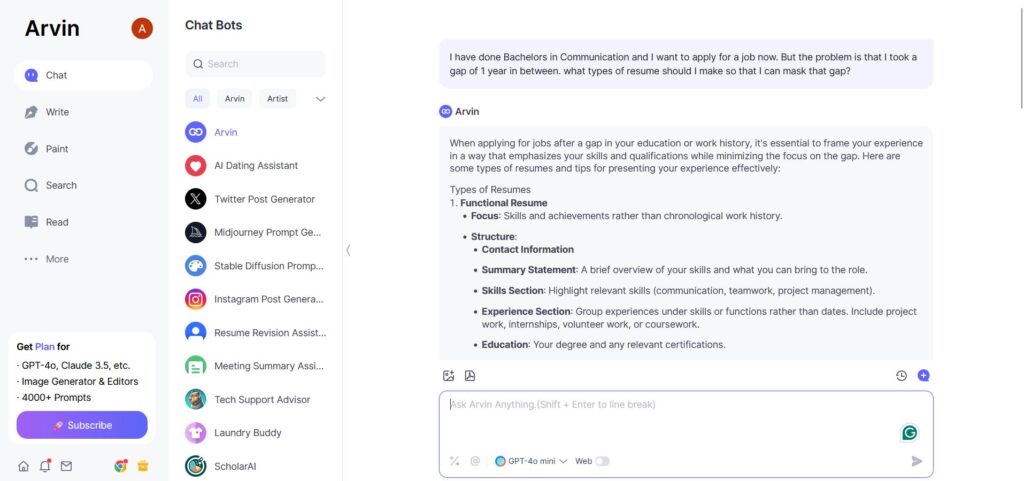
Key Elements Of A Best Resume Format
Here are the necessary elements every resume must have:
Contact Information
Start your resume with your contact information, which typically includes your full name, phone number, email address, and LinkedIn profile (if any). Here’s an example:
Example:
Jenny Marie | jennymarie@gmail.com | (555) 123-4567 | http://linkedin.com/in/jennywriter
Professional Summary Or Objective
In 2-3 lines, give a brief overview of your experience, skills, and career goals. This summary should depict what you bring to the table and be able to grab the employer’s attention.
Example:
Senior copywriter with over 5 years of experience crafting copy that drives action. Proven track record of increasing organic traffic and improving conversion rates.
Education Section
Whether you’re fresh out of college or decades into your career, your education section adds credibility to your resume. Here’s the right way to add your education to your resume:
List Your Degree(s): Include the type of your degree (e.g., B.A., B.S., M.S.) and your major.
Name the Institution: Don’t forget the school! If it’s a well-known institution, it can boost your appeal.
Add Dates (If Relevant): Only include your graduation year if you’re a recent grad. If you’re an experienced professional, you can leave this out.
Relevant Coursework (Optional): If you’re a recent graduate, list relevant classes you took to show you have the skills the job needs.
Example:
B.A. in Marketing | University of California, Los Angeles | May 2018
Experience Section
Describe similar work experiences in your past, and each experience must include job title, company name, duration of employment, and key accomplishments during your tenure.
Bonus Tip: Use bullet points to describe your responsibilities and achievements so that they are easier to scan through and easy for the recruiter to notice.
Example:
Digital Marketing Manager | Awesome Co. | Jan 2020 – Present
Skills Section
These days, companies pay a lot of attention to your skills, so this section is technically your superpowers section. However, you need to make sure the skills you’re mentioning are relevant or helpful in the job you’re applying for.
For instance, if you’re applying for a copywriting job, would adding Javascript to your skills be of any help? We would bet otherwise, so don’t just include hard skills, but also include soft skills like problem-solving (P.S. This does not mean you add hard work as a skill).
Example Skills Section:
Technical Skills: Adobe Creative Suite, Google Analytics, Microsoft Excel
Languages: Fluent in Spanish, Intermediate French
Here’s a sample resume you can take inspiration from:

Optional Sections
Here are a few additional sections you can include in your resume format to add more personality to your resume:
Certifications: Include any certifications relevant to your job (e.g. Project Management Expert)
Volunteer Work: Highlight any volunteer work (if you have any) to demonstrate your leadership or community involvement
Hobbies or Interests: Keep this section professional but interesting by mentioning hobbies like “playing competitive chess” instead of “watching Netflix”
Awards or Achievements: If you’ve won any industry awards or distinctions, flaunt them here (no, the employee appreciation day message you received does not count).
Essential Resume Formatting Guidelines
Here’s how to format a resume like a pro by following these essential resume formatting guidelines:
Keep It Simple And Clean
When it comes to resume formatting, less is more. Recruiters don’t have the time and energy to sift through overly designed resumes, so a simple resume format is the way to go. Here’s how to format a resume to grab attention:
Font Choices: Stick to classic, professional fonts like Arial, Calibri, or Times New Roman, and avoid fancy, hard-to-read styles.
Font Size: Use a font size between 10-12 points for the body text and 14-16 points for headings. This font size is easy to read, and looks decent as well.
White Space: Make full use of white space, and use margins of 0.5–1 inch to keep your resume from feeling overcrowded.
Use Consistent Formatting
Recruiters love a resume that looks like it’s been put together with care—because if you pay attention here, you’ll probably pay attention at work too. Here’s how to format a resume in a consistent way:
Uniform Headings: Use the same font, size, and style (bold, underline, or ALL CAPS) for each heading. Bonus points for you if you align them all perfectly!
Bullet Points: Choose one style and stick to it. Whether you like dots, dashes, or fancy little arrows, pick one, and please, don’t switch it up halfway through.
Dates: Whether you write “Jan 2023–Present” or “January 2023–Present,” stick to one style throughout your resume. Inconsistency is the enemy here, and you want to be friends with your resume!

Make It Easy to Scan
Think about it: recruiters are scanning resumes faster than you scroll TikTok, so make their life a little easier by using:
Short, Punchy Sentences: No long-winded paragraphs! This is your resume and not a cover letter, so use bullet points that get straight to the point.
Strategic Bolding: Highlight your job titles or key achievements so that the recruiter notes the highlights of your career. (Friendly advice: Don’t put everything in bold, or it’ll look like a ransom note.)
No Overkill on Graphics: Unless you’re a designer showcasing your work, keep things graphic-free. Fancy charts or logos may confuse Applicant Tracking Systems (ATS), and you don’t want to mess with those robots. If you do add graphics, the system may not recognize your format and will immediately reject your application without giving you a second chance.
Don’t Do This!
Don’t do these things if you want to save your resume from ending up as a funny work joke only:
Saving Your Resume As A Word File
While Word document is a widely used file type, do not share your resume as a Word document. This is because if you send your resume as a Word document, there’s a chance it could get messed up depending on the recruiter’s device.
Instead, always share your resume as a PDF because a PDF stays consistent no matter which device you use. You can always save a Word file of your resume for yourself to make easy changes later.
Randomly Naming Your File
How does “Resume_final_FINAL_v3.pdf” sound for a name? Sounds pretty bad to us! Always rename your resume with a professional name after you’re done editing it for the 100th time. An ideal file name would be something like “First name_Second Name_Job Title.pdf”, which gives a nice impression.
Sending Without Proofreading
Nothing screams “I didn’t try” like a typo on your resume. Don’t let it happen to you, and proofread your resume at least twice. You can also ask a friend to read your resume (hey, if you don’t have a friend, don’t worry. Ask Arvin AI’s Grammar Checker to proofread your resume and point out any grammatical errors that you might have missed).

FAQS About How To Format A Resume
Here are a few of the most frequently asked questions about how to format a resume the right way:
What is the difference between a resume and a CV?
The terms CV and resume are often confused as being the same thing, but they are two different types of documents. The main difference between a CV and a resume is that a resume emphasizes on your skills, while a CV emphasizes on your academic accomplishments.
Is it okay to say “I” in a resume?
Generally, it is recommended not to use the pronoun “I” in your resume because it looks unprofessional. You can always write your resume in a first-person narrative just without using “I”.
What is the best font for a resume?
You should use a font that is easy to read and looks professional. Some popular choices for resumes include Times New Roman, Arial, Garamond, and Cambria.
How many pages should my resume have?
Ideally, your resume should be summed up on one page. However, a 1-2 page resume is fine and should not exceed 2 pages.
How many skills should I list on my resume?
Anywhere between 8-15 unique skills for resume is a good number to begin with, but don’t just include any skills. Only include skills that are relevant to your job and that you’re actually good at them.
The Bottom Line
If you know how to format a resume correctly, you’re already halfway to your dream job. Remember, formatting a resume is more than just aesthetics. It’s about your sincerity with the job and showing that you’re actually serious about it. It will speak for your professionalism and attention to detail.
Take your time to tailor your resume according to the job you’re applying to, and take help from online resources and ChatGPT’s alternative tools like Arvin AI to write the best resume. You can also ask Arvin AI to review your resume and give you suggestions on how to improve it. Happy job hunting!
